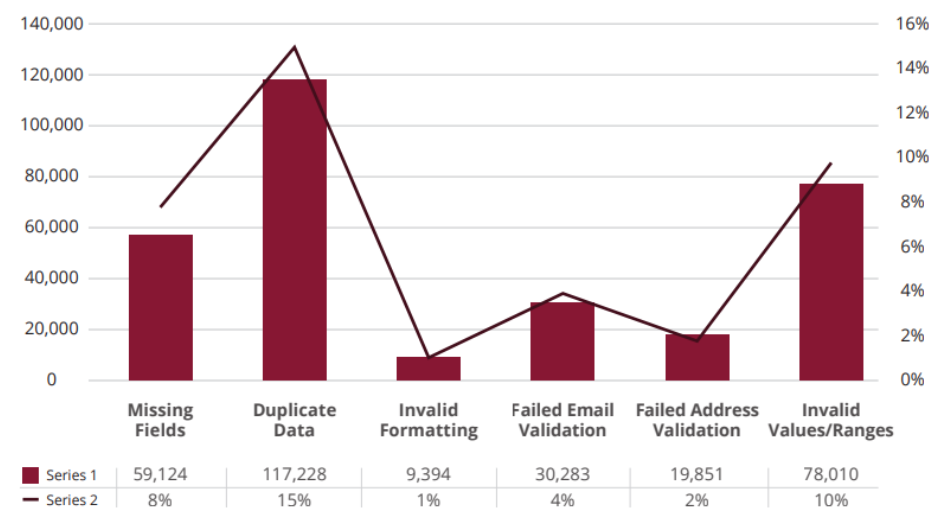Yuck! Is that your data you've left lying around? Ugh, it's all mouldy. And what's this? More data under the bed? Right, it's time to clean all this up.

Marketing data is used to give marketers a good look into their customers, from their personas to behaviours, attitudes to purchasing decisions. All of this will be kept in a database, in order to craft those all important personalised experiences.
However, when this is half-arsed, or not done correctly, the data can go from useful, to unusable.
In fact, Salesforce believes that 70% of incomplete recorded data becomes obsolete within the year.
Outdated, duplicate, or inaccurate data can lead to marketing that can be described in similar terms. Your customer might've been looking for "World's Biggest Game of Thrones fan" T-shirts before the finale, but if you're not updating their preferences, it'll hit a sore spot. All of this leads to missed opportunities, bad relationships, and loss of sales.
Between 2019-2021, over 40% of sales reps didn't have enough info about their leads to maker effective sales. So, you can see the real-life consequences of having poor data cleanliness.
But it's not all bad news. The University of Texas has estimated that if the data is just 10% more accurate, then revenue can be considerably boosted, not only for big enterprises, but also for small firms, B2B, and B2C organisations.
But first up: definitions.
What is Clean Data?
Clean data needs to hit a few standard to be considered 'clean'. But, for the most part, 'high quality' data can be a very subjective term. It needs to be relative to its purpose, and agree with the data you already have. This tends to be pretty easy if you've created the data yourself, but if you source it externally, it'll be trickier.
Cleansing data, as a result, becomes a constant and frequent process, where you'll first need to focus on completeness, and then move onto the accuracy and relationships.
So, to judge tour data as 'clean', you'll have to consider it alongside the following five categories:
- Validity. Your data is accurate.
- Accuracy. Your data is up to date.
- Completion. Your data has all the necessary fields filled in.
- Duplicity. Your data contains no duplicate information or errors.
- Consistency. Your data values have an element of consistency with its use of units of measurement.
I know this seems like a bunch of work. And who wants that? The only thing is that inaccurate data is absolutely useless. The Data Warehousing Institute estimates that businesses in the United States lost $611 billion due to low quality customer data. That's billion with b.
And that's just the loss quantified; consider all the customers alienated and frustrated by poor data quality, and the effect this has on a company's credibility.
What is Dirty Data?
Dirty data is a database record that contains errors; exactly what you need to avoid. These data inaccuracies can come from the beginning or along the way, from inaccurate input or changes that have since occurred.
TDWI has even found that roughly 2% of the information on customers becomes obsolete within one month of collection, due to sudden life changes. Unfortunately, customers tend to do human things, like "die, divorce, marry, and move".

Good and accurate data is the foundation for any effective marketing campaign. Without it, companies are unable to interact with customers precisely, or respond to shifts in dynamics with speed. Other consequences of dirty data include:
- Inaccurate customer metrics
- Decrease revenue
- Tracking errors
- Incorrect marketing segmentation
- Misleading customer records
- Missed opportunities
- Damaged relationships
How do you clean data?
It's not just a case of bringing out the Cillit Bang.
It's important to make a clear distinction between data cleaning with data purging. Clean data can be achieved with deleting old records, which can be used in a number of ways, such as reactivation campaigns or generating scoring models. So, it's more important to focus on cleaning, i.e. getting rid of useless data, and filling in the gaps.
Useless data can be scrubbed clean by:
- Completing a data audit to identify discrepancies
- Setting data cleaning workflow constraints with your team, so they're prepared to work with the programme on any discrepancies.
- Executing the data cleaning workflow
- Reviewing the data, as a means of quality assurance, and to correct anything inaccurate
So, what parts of cleaning your data should you focus on? Well, you'll need to:
Identify and eliminate duplicates. It's important to find duplicates and remove them from your database. Having a name or number feature more than once just inflates your email list and produces inaccurate figures. You don't even have to trawl through all these manually; there's plenty of tools that will work through your list for you.
Delete inactive and junk contacts. Sending all your well-crafted, made-with-love emails to spam accounts or dormant contacts is useless. Think how much time you spent picking out that perfect Parks and Rec gif, just wasted. This is another task you can sub a robot in for - there's email verification tools that will detect dummy accounts, and improve your sender score, within minutes.
But remember to study your email marketing metrics, like open rates and click-through rates. If these are incredibly low, it might not be the Lesley Knope gif. If you have a bunch of cold leads that aren't responding, it might be best to let them go, and focus on the ones that are responsive.
Sorting out missing data. Making sure all those missing values are filled in is vital for good quality data. Missing your customer's first name? Then all their emails are going to the highly valued customer Mr. *|FNAME|*. Missing a postcode? Your direct mail will never reach its target. These missing sections can be filled out using external parties.

Why is data cleansing important?
Well, there's a few reasons. These can include:
- Avoiding Costly Errors. Cleaning data is a preventative measure, rather than reactive. So, companies can avoid costs that crop up because of inaccurate data. If your data sends something to the wrong address, you'll have to pay for redelivery. Pre-empting this saves a nice chunk of change.
Having duplicate data can also clutter up the work environment, leading to inefficient processes. Plus, teams will have a much clearer look into overarching customer behaviour - if the data is clear and complete, they'll be in a better position to see customer demands and new opportunities, without bad data obscuring it all. - Making data work across different channels. Having clean data clears the path for the management of multichannel customer data. This accurate customer information means your contact strategies can be successfully executed across channels.
- Improved customer acquisition. This one's self explanatory. Companies that have well-kept data can interact with prospects in a way which is effective, thanks to the ability to develop this list with their most accurate personal preferences and information.
- Easing the decision-making process. Clean data can improve a business's ability to make decisions, as they can rely on the report's accuracy. Data cleansing cleans up the unnecessary clutter and noise, and allows for quicker, more informed decisions. Having access to information allows companies to make better decisions. And this means a competitive advantage.
- Increased Productivity. Improved data quality affects your team. When inaccurate data is removed, or updated, teams have a good base on which to work. When they're left with the highest quality information, they don't have to use excess resources and time to sift through what is relevant, and what isn't.
A cluttered database can lead to a decrease in productivity. Computers won't have to slowly sift through mounds of data, and client menus won't be filled with past clients. Plus, silly, avoidable mistakes can be avoided. - Reduced privacy mistakes. You don't want to be sending private, sensitive information to an inaccurate address. This'll damage relationships with customers, and possibly lead to legal issues.



